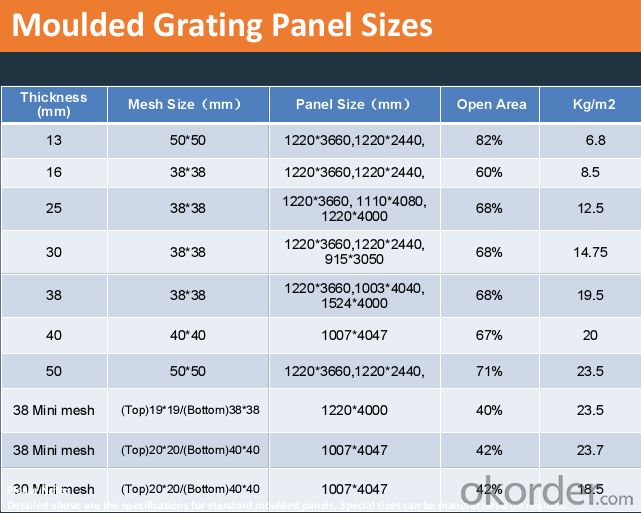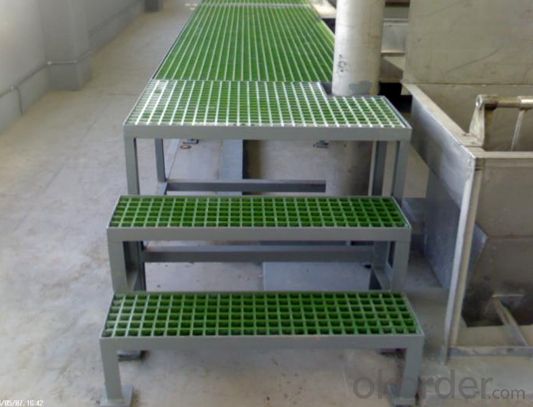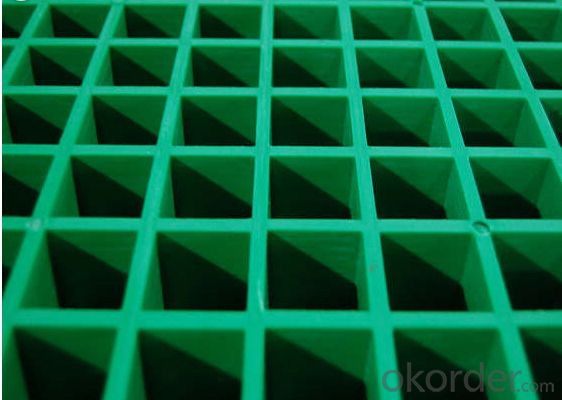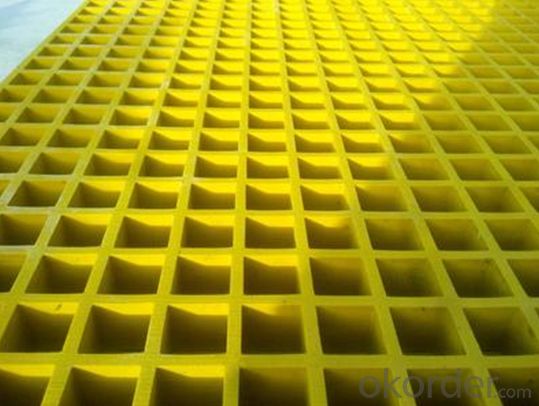Frp Molded Grating
- Loading Port:
- Shanghai
- Payment Terms:
- TT OR LC
- Min Order Qty:
- -
- Supply Capability:
- 20000m2 m.t./month
OKorder Service Pledge
Quality Product, Order Online Tracking, Timely Delivery
OKorder Financial Service
Credit Rating, Credit Services, Credit Purchasing
You Might Also Like
Specifications
fiberglass mesh grating
1.meet ASTM E-84 AND ISO9001
2.anti-corrosion floor
3.anti-conductive
4.walkway,platform,trench cove
fiberglass mesh grating
Corrosion and Chemical resistant;Slip-resistant ;High strength-to-weight ratio;Ergonomic ;Low maintenance ;Fire retardant ;Easily fabricated and installed
Panel Size:




- Q:Can FRP pultrusion profiles be used in the construction of railway sleepers?
- Yes, FRP (Fiber Reinforced Polymer) pultrusion profiles can be used in the construction of railway sleepers. FRP pultrusion profiles offer several advantages that make them suitable for this application. Firstly, FRP pultrusion profiles are lightweight yet strong, making them ideal for railway sleepers. They have high strength-to-weight ratios and can withstand heavy loads, making them a reliable choice for supporting the weight of trains. Additionally, the lightweight nature of FRP profiles makes them easier to transport and install, reducing construction time and costs. Secondly, FRP pultrusion profiles are highly resistant to corrosion, which is a crucial factor for railway sleepers. Traditional materials such as wood or steel are susceptible to corrosion when exposed to moisture and chemicals. FRP profiles, on the other hand, are non-corrosive and do not require regular maintenance or replacement due to rust or decay. Furthermore, FRP pultrusion profiles offer excellent durability and longevity. They are resistant to UV radiation, extreme temperatures, and chemicals, ensuring a longer lifespan compared to traditional materials. This reduces the need for frequent replacements, resulting in lower maintenance and lifecycle costs. Moreover, FRP pultrusion profiles can be customized to meet specific design requirements. They can be manufactured in various shapes and sizes to fit different railway sleeper designs, offering flexibility in construction. Additionally, they can be made in different colors, allowing for aesthetic customization. Lastly, FRP pultrusion profiles offer excellent electrical insulation properties. This is crucial for railway sleepers, as they need to provide insulation between the train tracks and the ground to prevent electrical interference and ensure safe operation. In conclusion, FRP pultrusion profiles are a suitable choice for the construction of railway sleepers due to their lightweight, high strength, corrosion resistance, durability, customization options, and electrical insulation properties.
- Q:Are FRP pultrusion profiles resistant to wear or abrasion?
- Yes, FRP (Fiber Reinforced Plastic) pultrusion profiles are highly resistant to wear and abrasion. The combination of the reinforcing fibers, typically glass or carbon, and the plastic resin matrix creates a material that is incredibly durable and can withstand heavy usage. The pultrusion process also ensures a homogeneous structure with fibers evenly distributed throughout the profile, further enhancing its resistance to wear and abrasion. Additionally, FRP pultrusion profiles can be engineered with specific additives or surface treatments to further enhance their resistance to wear and abrasion, making them suitable for a wide range of applications in various industries, such as construction, transportation, and marine.
- Q:Are FRP pultrusion profiles resistant to caustic solutions?
- FRP pultrusion profiles are known for their resistance to caustic solutions. The combination of reinforcing fibers and the polymer matrix used in FRP pultrusion provides exceptional chemical resistance. Unlike traditional materials like steel or wood, which can be corroded or degraded by strong alkaline substances, FRP pultrusion profiles are highly resistant to chemical attack. This makes them suitable for industries that frequently encounter caustic solutions, such as chemical processing, wastewater treatment, and marine environments. However, it is important to refer to the manufacturer's specifications and guidelines to ensure compatibility between specific caustic solutions and the chosen FRP pultrusion profile.
- Q:Can FRP pultrusion profiles be used in the construction of swimming pool enclosures?
- Swimming pool enclosures can make use of FRP pultrusion profiles, which are known for their excellent strength-to-weight ratio, corrosion resistance, and durability. This makes them an ideal choice for outdoor applications like swimming pool enclosures. To manufacture FRP pultrusion profiles, fiberglass rovings are pulled through a resin bath and then through a heated die. This results in a continuous profile of uniform shape and strength. This manufacturing process ensures that the profiles are strong, stiff, and lightweight, making them easy to handle and install. In the construction of swimming pool enclosures, FRP pultrusion profiles can be utilized for various structural elements such as beams, columns, trusses, and panels. These profiles provide the necessary strength and support, while also offering resistance to corrosion, moisture, and UV radiation, which are common challenges in a swimming pool environment. Furthermore, FRP pultrusion profiles can be customized to meet specific design requirements, allowing for flexibility in creating unique and aesthetically pleasing swimming pool enclosures. They can be fabricated in different shapes, sizes, and colors, enabling the desired architectural look and feel. Overall, FRP pultrusion profiles offer a reliable and long-lasting solution for constructing swimming pool enclosures. They provide the necessary strength, durability, and resistance to environmental factors. Additionally, their lightweight nature simplifies handling and installation, ultimately reducing construction time and costs.
- Q:Are FRP pultrusion profiles UV resistant?
- Yes, FRP (Fiber Reinforced Polymer) pultrusion profiles are typically UV resistant. This is because they are manufactured using a combination of polymer resin and reinforced fibers such as fiberglass. These materials have inherent UV resistant properties, making FRP pultrusion profiles resistant to damage caused by prolonged exposure to sunlight and ultraviolet radiation. UV resistance is a crucial characteristic for outdoor applications where the profiles will be exposed to sunlight, such as in construction, infrastructure, and marine industries. However, it is important to note that the level of UV resistance may vary depending on the specific resin and fiber composition used in the manufacturing process. Therefore, it is recommended to consult the manufacturer or supplier for specific information on the UV resistance of FRP pultrusion profiles for a particular application.
- Q:Can FRP pultrusion profiles be used for structural applications?
- Certainly, FRP pultrusion profiles can be utilized for structural purposes. The process of pultrusion involves pulling fiber reinforcements through a resin bath and a heated die to cure the resin, resulting in robust, lightweight, and corrosion-resistant profiles with exceptional mechanical properties. The high strength-to-weight ratio of FRP pultrusion profiles makes them widely employed in different structural applications. These profiles can be engineered to possess specific load-bearing capacities, stiffness, and durability, making them suitable for a wide range of structural requirements. FRP pultrusion profiles find common use in various structural applications such as bridges, walkways, platforms, handrails, supports, beams, columns, and reinforcements in concrete structures. They are particularly advantageous in situations where traditional materials like steel or wood are unsuitable due to concerns regarding corrosion, electrical conductivity, or weight. The benefits of FRP pultrusion profiles are numerous. They are lightweight, making them easy to handle and transport. Furthermore, they exhibit resistance to corrosion, chemicals, and UV radiation, ensuring long-term durability even in harsh environments. Additionally, they possess excellent dimensional stability, remaining unaffected by warping, twisting, or shrinking over time. To summarize, FRP pultrusion profiles are highly suitable for structural applications owing to their strength, lightweight nature, corrosion resistance, and durability. They provide a cost-effective alternative to traditional materials while delivering superior performance in various structural projects.
- Q:Can FRP pultrusion profiles be used in chemical storage tanks?
- Yes, FRP pultrusion profiles can be used in chemical storage tanks. FRP (Fiber Reinforced Plastic) materials are known for their excellent corrosion resistance and durability, making them an ideal choice for storing various chemicals. The pultrusion process further enhances the strength and structural integrity of the profiles, making them suitable for demanding applications like chemical storage tanks.
- Q:Are FRP pultrusion profiles resistant to rotting or decaying?
- FRP pultrusion profiles possess a high resistance to rot and decay due to their composition, consisting of a combination of fiber reinforcement, like fiberglass, and a polymer resin matrix. Unlike wood and other conventional materials that rot and decay when exposed to moisture and environmental elements, FRP profiles do not absorb water as they are non-porous. Moreover, the polymer resin employed in FRP exhibits exceptional resistance to chemical corrosion, rendering it impervious to rot-causing agents such as fungi or bacteria. Consequently, FRP pultrusion profiles boast a significantly longer lifespan and necessitate minimal maintenance in comparison to traditional materials, making them an exceptional choice for applications that demand resistance to rot or decay.
- Q:Are FRP pultrusion profiles resistant to weathering?
- FRP pultrusion profiles exhibit exceptional resistance to weathering, thanks to the pultrusion process. This process generates a robust, long-lasting, and non-corrosive material that inherently withstands diverse weather conditions. Comprised of a fusion of fiberglass reinforcements and a thermosetting resin matrix, FRP profiles boast a unique composition that delivers outstanding protection against UV radiation, moisture, chemicals, and temperature changes. Consequently, these profiles prove ideal for outdoor applications. Extensive testing has verified that FRP pultrusion profiles retain their structural integrity and physical properties even after prolonged exposure to harsh weather conditions. Unlike conventional materials such as wood or metal, they do not degrade, warp, or crack due to sunlight, rain, snow, or extreme temperatures. The exceptional weather resistance of FRP pultrusion profiles enables their utilization across a broad range of industries, including construction, infrastructure, marine, and transportation. Moreover, these profiles exhibit a low thermal expansion and contraction rate, ensuring dimensional stability in fluctuating weather conditions. This quality prevents warping or distortion over time, making FRP pultrusion profiles an excellent choice for long-term outdoor use. To summarize, FRP pultrusion profiles excel in weather resistance and offer enduring durability in various outdoor environments. Their capacity to endure UV radiation, moisture, chemicals, and temperature fluctuations makes them a dependable and cost-effective solution for diverse applications.
- Q:How are FRP pultrusion profiles manufactured?
- FRP pultrusion profiles undergo a highly controlled and precise manufacturing process. The process consists of several steps. To begin with, the raw materials are carefully chosen. These materials typically include reinforcing fibers like fiberglass, carbon fiber, or aramid, as well as a thermosetting resin matrix. The selection is based on the desired mechanical properties of the final product. Following that, the resin matrix thoroughly saturates and coats the reinforcing fibers. This can be achieved by immersing the fibers in a resin bath or using a resin injection system. Once the fibers are fully impregnated, they are pulled through a heated steel die. The die not only shapes the pultrusion profile but also activates the resin's curing process. This allows the resin to harden and bond the fibers together. While passing through the die, the fibers are continuously pulled by a set of rollers or a gripper system. This pulling force ensures that the profile maintains its shape and dimensions, resulting in a consistent and uniform product. After leaving the die, the profile enters a cooling zone where it is rapidly cooled using air or water. This rapid cooling helps solidify the resin and stabilize the profile's shape. Finally, the cured and cooled profile is cut to the desired length, often using automated cutting systems. Additional finishing processes, such as surface treatment, sanding, or painting, may be implemented to meet specific requirements or enhance the profile's aesthetics. In conclusion, the manufacturing process for FRP pultrusion profiles combines the impregnation of reinforcing fibers with resin, the shaping of the profile through a heated die, and the curing and cooling steps. This process enables the production of lightweight, corrosion-resistant profiles with high strength. These profiles find applications in various industries, including construction, aerospace, automotive, and electrical.
1. Manufacturer Overview |
|
|---|---|
| Location | |
| Year Established | |
| Annual Output Value | |
| Main Markets | |
| Company Certifications | |
2. Manufacturer Certificates |
|
|---|---|
| a) Certification Name | |
| Range | |
| Reference | |
| Validity Period | |
3. Manufacturer Capability |
|
|---|---|
| a)Trade Capacity | |
| Nearest Port | |
| Export Percentage | |
| No.of Employees in Trade Department | |
| Language Spoken: | |
| b)Factory Information | |
| Factory Size: | |
| No. of Production Lines | |
| Contract Manufacturing | |
| Product Price Range | |
Send your message to us
Frp Molded Grating
- Loading Port:
- Shanghai
- Payment Terms:
- TT OR LC
- Min Order Qty:
- -
- Supply Capability:
- 20000m2 m.t./month
OKorder Service Pledge
Quality Product, Order Online Tracking, Timely Delivery
OKorder Financial Service
Credit Rating, Credit Services, Credit Purchasing
Similar products
New products
Hot products
Related keywords



























